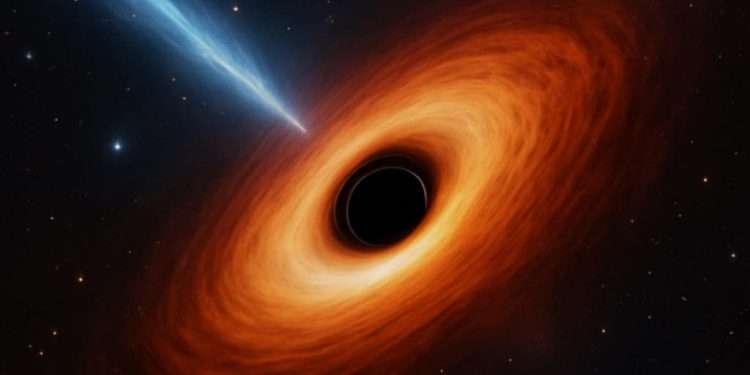The Massachusetts Institute of Technology published an important discovery of dormant black holes located inside dusty galaxies on July 24, 2025.
Introduction
The Massachusetts Institute of Technology (MIT) research team revealed on July 24, 2025 that dormant black holes exist within dusty galaxies which feed on stars without creating standard observational signals for astronomers. Scientists have discovered a hidden population of dormant black holes which challenge current understanding of black hole evolution processes and stellar destruction in space.
The Silent Killers: What Are Dormant Black Holes?
Scientists classify black holes into two main categories which include active and dormant types. The active state of black holes enables them to consume gas and matter which produces quasars and X-ray jets that scientists can observe from distances spanning millions of light-years. Dormant black holes exist as invisible objects because they consume stars with minimal light emission.
Scientists face significant difficulties when attempting to detect dormant black holes. These black holes stay invisible because they do not emit bright light which enables them to merge with their surrounding galaxy backgrounds especially in environments filled with dust that blocks both infrared and optical wavelengths.
The MIT researchers with their team of scientists discovered a new method to spot these rare black hole entities through their research using NASA’s NEOWISE and Pan-STARRS telescope data.
A New Technique for Black Hole Detection
The scientists investigated tidal disruption events (TDEs) to study cosmic catastrophes that occur when stars approach black holes too closely thus experiencing gravitational disruption. The black hole absorbs stellar debris through a short-lived energy flare that develops when stellar material spirals into the black hole.
The flares become visible in optical or X-ray frequencies yet they become undetectable when observed in dust-rich galaxies due to dense interstellar clouds blocking most traditional wavelengths of light.
So how did the team find them?
The researchers employed infrared light because it passes through dense interstellar material better than visible or X-ray light does. Scientists analyzed infrared data from NEOWISE archives and compared it to Pan-STARRS optical brightness data to detect 18 possible TDEs in dust-obscurations galaxies.
The discovery of dust-obscured tidal disruption events represents the first detection of these events and indicates that numerous similar events occur beyond what astronomers previously thought.
What This Means for Astronomy
The results from this research have deep significance for the field of astronomy.
1. TDEs May Be Much More Common
Scientists had estimated that tidal disruption events appeared once every 10,000 to 100,000 years within a single galaxy until this research became available. The current estimate of TDE occurrences appears to be significantly wrong. Scientists have discovered TDEs in dust-obscured galaxies that were previously invisible which suggests the actual rate of such events may be multiple times higher.
2. Black Hole Growth Is Underestimated
New research indicates that dormant black holes feed on stars in complete silence since they do not produce detectable signals. The process of stealth feeding appears to be essential for black hole mass growth and the evolution of galaxies in environments containing abundant gas and dust.
3. Recalibrating Our Cosmic Models
Most galaxy evolution models depend on visible light data yet the new findings indicate there exist multiple hidden patterns of cosmic behavior. The astronomical community should start using infrared-based observation methods because this new evidence shows dusty areas of space contain many undetected phenomena.
4. The JWST Will Be Essential
The James Webb Space Telescope (JWST) operational status makes its infrared observation system ideal for future studies. Scientists can use JWST to detect these inactive black holes more precisely while studying the chemical makeup of star debris using its powerful infrared technology.
The Role of Dust in Hiding Black Holes
Old stars have left behind carbon and silicon particles together with metal fragments which form the dust that fills galaxies. The dust exists in large quantities throughout active star-forming regions. The combination of light absorption and scattering by dust prevents optical telescopes from detecting internal structures.
Modern astronomy benefits from NEOWISE and JWST because these space-based observatories do not absorb infrared light as efficiently as other telescopes do.
The MIT research indicated that most concealed TDEs appeared within active star-forming galaxies which backed up the connection between dust-rich environments and inactive black holes.
The Human Perspective: Why This Discovery Matters
This discovery marks more than a technical achievement because it shows how many secrets remain hidden throughout the universe. The advancement in technology allowed us to observe what was present all along in open sight.
The research discovery will guide scientists in their search for life-sustaining planetary systems across the universe. Our current inability to detect black holes behind cosmic dust indicates there could be additional hidden phenomena in space.
Final Thoughts
The discovery made by MIT on July 24th marks a new direction for studying black holes. The universe proves to be more violent and active and perhaps more mysterious than human understanding has shown.
Our observational techniques now need to incorporate infrared detection to reveal previously unknown cosmic phenomena which include both hidden black holes and unobserved galactic events.
Scientists must deepen their curiosity after receiving this scientific call. The public should understand that space contains unidentified cosmic wonders which lie beyond human comprehension at this time.

